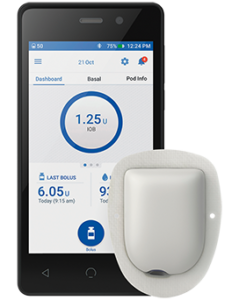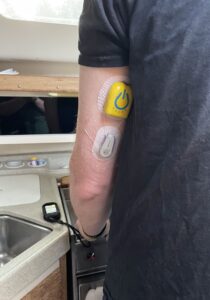Omnipod DASH pods were introduced to Australia last August, but while the company continues to work towards getting them subsidised like other insulin pumps through a combination of NDSS and private health insurance, we’re still left having to fund them as self-payers.
They’re expensive
 A box of 10 pods (one month’s supply if you’re using them full-time) is AU$420. Two boxes would be $810. These prices are not sustainable for many people, so subsidised access will be key to access for most of us. I only use a pod every now and then: relying on them full-time would be too expensive for me.
A box of 10 pods (one month’s supply if you’re using them full-time) is AU$420. Two boxes would be $810. These prices are not sustainable for many people, so subsidised access will be key to access for most of us. I only use a pod every now and then: relying on them full-time would be too expensive for me.
The current Federal Health Minister made statements a while back that these should be subsidised, although with the different economic model to traditional pumps it seems there’s some restructure to existing systems needed to implement that, and it hasn’t happened yet.
I received my PDM handset included with my starter box, and I believe this is still the arrangement. I had to get a letter of clinical need (from an endo or in my case my DE) and then had to arrange “pod training” and be certified as a competent user. But now that I’m set up I’m registered on their system, and can easily order more boxes online at any time (and return used pods to them in a recycling program).
Conveniently my DE was one of the first to be certified as a trainer, so it was all straightforward for me. Although I understood the manual already and (as someone who’s used most pump models out there) I knew what I was doing, the company insists on official “pump start” training for everyone. I only mention that to highlight that anyone wanting to start “podding” will need to factor in the time and costs for these setup steps.
Deals, deals, deals!
Recent news from Insulet Australia is that there are two offers currently on:
- “Product Familiarisation Program”
Gets you set up as a pod user, with a starter box of 10 pods. The cost is $30 (plus the above “incidentals”).
Apparently available to the first 500 people (before the end of July). - “Subsidised Access Program”
Where we can order 2 boxes ($810) but receive FOUR boxes. Available twice per person, up until the end of October.
Obviously for existing users who are forking out the money for their pods hand over fist, getting up to another 4 months of pods “for free” could be wonderful.
And $30 (plus endo/DE appointments) to try out pods for a month and see if you like them is great! After that you’d be registered as a pod user for ongoing access. But it doesn’t require you to stop using an existing pump outright (or affect the replacement timeframe for your pump through insurance).
On their side, it seems a reasonable guess that Insulet has ended up with a warehouse of pods which are getting older (they do have expiry dates) and need to be cleared. Also the more people they have registered as pod users and set up to use them, the faster the company’s business can take off if/when the pods are subsidised. Either way, it presents us with opportunities!
What I think of pods
My personal opinion of the Omnipods is that they’re an interesting option. They are a pump like all the others, and provide the same basic functions that are shared with all other pumps, such as:
- Quick, discreet, and precise boluses.
- Inbuilt dose calculator.
- Basal control (unlike injections of long-acting insulin, you can decrease/increase the background insulin as needed).
- Record keeping of doses, carbs, etc.
I do hear some people who started pumping with Omnipods raving about those features, but it is worth remembering that they’re not unique to pods. Omnipods do have their own special features though.

Personally I use pods interspersed with use of tubed pumps. I use them (in a looped configuration) but mainly for special occasions (e.g. I wore one over Easter as we were sailing).
You can see in this image I arranged to have my pod and my G6 sensor in the same area of my body to simplify radio comms to both from the tiny looping phone that’s on the galley bench in front of me (usually it was in a pocket of course). With the different cycle times for each device, coordinating those locations for this trip was a juggle.
Analysing the pros and cons which separate pods from traditional “tubed” pumps, I came up with the following list. You may be able to find your own as well.
Pros to pods:
- No need to disconnect for showers/swims.
One less thing to do when walking into the shower. Don’t need to leave the pump on the beach or at the poolside. - No flexibility in cannula cycling.
You’re forced to change the cannula regularly, which for some people helps them stick to a healthy routine. - Easy insertion.
Stick on the pod, and once it’s activated by the handset it takes care of inserting the cannula by itself. You do feel it for an instant, but it’s very straightforward. - No tubing to tangle on things.
Rarely an issue for me personally, as my pump and tubing are usually hidden away in a tiny belt under my clothes. But an issue for some people. - Discreet to operate (“phone-like” wireless handset).
An advantage shared with other pumps like the Solo and Combo. - “No big pump to handle”.
Not an issue for me. I don’t use a current Medtronic pump. I must admit the Tandem t:slim feels like a solid brick to me. But my usual YpsoPump and Combo pumps just hide out of the way. - Loopable.
These can be used in DIY automated (AID) systems using AndroidAPS 3+. Loop on iPhones has support for them in the development branch, although not yet in the main release.
Cons to pods:
- No flexibility in cannula cycling. Yes, just like the “pro” above.
If I’ve got a bad site, I have to replace the whole pod, rather than just changing the cannula early.
The fixed 72-80 hours lifespan doesn’t allow for flexibility when travelling between timezones, changing between day/night shifts, or just having “life events” coming up at different times.
The time we change this pod affects when we’ll ned to change the next pod. I prefer the flexibility to change a cannula early (or slightly late) to suit my life. - No flexibility in fill volumes.
The pod needs to be filled with between 85-200U. I have to guesstimate how much insulin will last 72-80 hours (for me that’s been around 110U lately). I run the risk of either wasting pods or insulin. - No choice in cannula type possible.
It’s a small teflon 6.5mm cannula at an angle. Some people prefer steel for example. - No flexibility in pump location until the next pod change.
Once it’s on I can’t move it (without throwing it away). Reasons to move it can be for comfort, for fashion, and for radio reception.
Reception can be a bigger issue with looping versus intermittent PDM use. - Need to be careful with static.
Not something that has occurred to me yet, but I’ve heard reports of static (e.g. from some clothes) sometimes killing pods. Something to watch out for. I haven’t actively tested for this mainly because these things are expensive!  Not silent.
Not silent.
Not everyone cares about the clicking, but I’m used to a silent pump that only makes noise or vibrates when it wants my attention. The click of each 0.05U with a pod is quite noticeable. To my cats as well as to me!- Oh, and expensive. But I’ve already talked about that.
So for me overall it’s a bit of “swings and roundabouts”. Whenever I finish using pods and revert to my tubed pump, I do feel like I’m coming back to comfortable ground. I do admit I prefer my tubed pump for normal operation, and each time feel comforted when going back to it. To me the pods feel more restrictive in use than a traditional pump, but at the same time they are more convenient for some situations.
But then for other people the pros are compelling!
Backup pumps!
Even if using another pump, having pods on hand does provide backup. For example if your pump dies and has to get replaced under warranty, that can take days to happen. And if I’m travelling at the time I might not get the replacement pump until I return home. But if you have some pods and insulin with you, there’s a convenient backup so you can keep pumping.
The main “gotcha” with just keeping pods around for backup is that they have expiry dates. As well as the question of how long they will be sterile for, they have internal batteries which presumably won’t last forever.
Conclusions
It’s of course up to you to draw your own conclusions. But hopefully I’ve pointed out some of the issues that you’ll need to consider.

I’m usually filling the pod with more insulin than I needed. To reduce waste, if there’s more than 15-20 u left in the pod at the end of its life I suck it back with the syringe and reinject it together with new insulin in the new pod. YMMV but it’s been working well for me for the past year.
I would always be cautious about things like that, and if I did it for one pod I would try to not do it for the next. The insulin ages in the plastic reservoir, and any contamination/decay that developed (especially after many cycles) could carry on to the next. When I used to refill my Animas reservoirs I would only do a few in a row for that reason.
Luckily most of us in Australia don’t have to be quite so economical with insulin due to our PBS subsidy.
Just to add that if I see that I’m running the risk of running out of insulin in the pod, i do inject manually with a pen some bulk insulin at time of meals and let the pod fine-tune with smaller injections. That’s to prevent removal of the pod before the 80 hours which I stick to religiously as I also pay out of pocket for it 🙂
When is the next review of the omipod subsidy due in Canberra? Will it take 10 yrs of waiting ?
I really hope this government and manufacturers will understand our needs a bit more. I love the tubeless omnipod as I don’t get it caught or bump it on things like door handles or kitchen sinks etc. plus it’s waterproof, so giving my clients showers and medications, injections is much less stressful.
Keep up the good work Wookie!
Chris the Tijuana Diabolico???
Thanks for the article which is useful with the recent NDSS announcement.
How long are unopened pods valid for before they expire?
Thanks!
It varies on what’s coming out of the warehouse. I’d say usually 6-12 months.
Hi David, I have been waiting to start on my Omnipod trial. Needing a Diabetic educator is a joke ( I have used pumps in the past and set them up myself.) Educators are stated I needed to see the Dietitian, even though I am married to a Dietitian who has worked for Diabetes Australia and has done his PhD on Glycaemic load and Glycaemic Index = totally ridiculous. As they have to “ follow a protocol “.
I am also a RN and Speech Pathologist who has had diabetes for 47 years.
It is amazing how every Type 1 is treated like an idiot.
That was my little bitch session.
I am wanting to know the Apps for looping.
Thanks
A DE is needed to sign off and basically indemnify Insulet from supplying a medical device to a random person. It’s a paperwork check-box, sure. I think your whinge about a particular DE being insistent about consulting a dietitian may be a separate issue. It’s not something I’ve encountered.
Any idea when the Omnipod 5 might be hitting our shores in Australia?
Nope. And it’s going to be a mystery for a while.
The nature of getting approval for medical devices means that Insulet Australia can’t talk about it (hardly even to acknowledge the OP5’s existence) to Australian consumers. They are essentially prohibited by law from “promoting” unapproved products.
Once it gets to approval, then they’ll be able to talk about it. But it’s usually a while after that before products actually become available to us.
For now we just have to wait.
This applies to all vendors, not just Insulet.
Any news on any official closed loop support with the G6? I believe it is approved in the US.
That’s the Omnipod 5, a different system to the Omnipod DASH.
No I haven’t heard any news about where it is up to for us. I wouldn’t expect it in a hurry, but who knows?